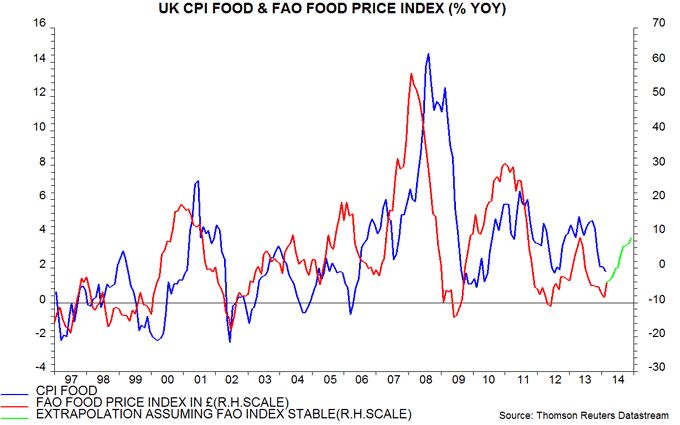Consumer price inflation fell from 1.9% in January to 1.7% in February, reflecting favourable effects from motor fuel costs, gas / electricity prices and clothing. This decline was expected and the forecast here remains for inflation to rise from the spring and end the year at about 2.75%. This assumes a firming of core pressures in lagged response to faster monetary growth and eroding spare capacity, and a rebound in food / energy costs.
The annual rise in food prices has slowed from 4.1% to 1.8% over the past 12 months, cutting 0.2 percentage points from CPI inflation. A surge in global food commodity prices since December, however, suggests that CPI food inflation is close to a low and will revive to 3-4% by late 2014 – see first chart*. There may be additional upward pressure from domestic supply disruption due to the recent floods.

Annual energy price inflation has fallen from 4.0% to 0.6% over the past year, cutting a further 0.3 percentage points from the CPI rate. Motor fuel costs in February were 5.5% lower than a year before but are assumed to rise modestly later in 2014, as ongoing solid global economic expansion is reflected in a firmer oil price. Gas / electricity prices will be restrained by recent government initiatives but may still increase by about 5% over the course of 2014. The forecast here assumes that energy inflation returns to about 4% by end-2014.
“Core” CPI inflation, i.e. excluding energy and unprocessed food and adjusted for changes in VAT and undergraduate tuition fees, was 1.9% in February, unchanged from October but down from 2.5% a year before. Trends in core inflation have followed monetary growth with a lag of about two years, in line with the monetarist rule – see previous post and second chart. This relationship suggests that the core rate is bottoming and will rise over the remainder of 2014 – the forecast assumes a return to 2.5% by year-end.

The forecast could be undershot if sterling rises further, particularly against the dollar. The US economy, however, may surprise positively in mid-2014 based on recent narrow money strength – see previous post – lifting interest rate expectations and the currency.
The suggestion that inflation is bottoming is supported by the alternative RPIJ measure, based on the components and weights of the RPI and the CPI’s calculation method. This measure reached a low of 1.9% in October and was 2.0% in February.
*FAO = UN Food and Agriculture Organisation.